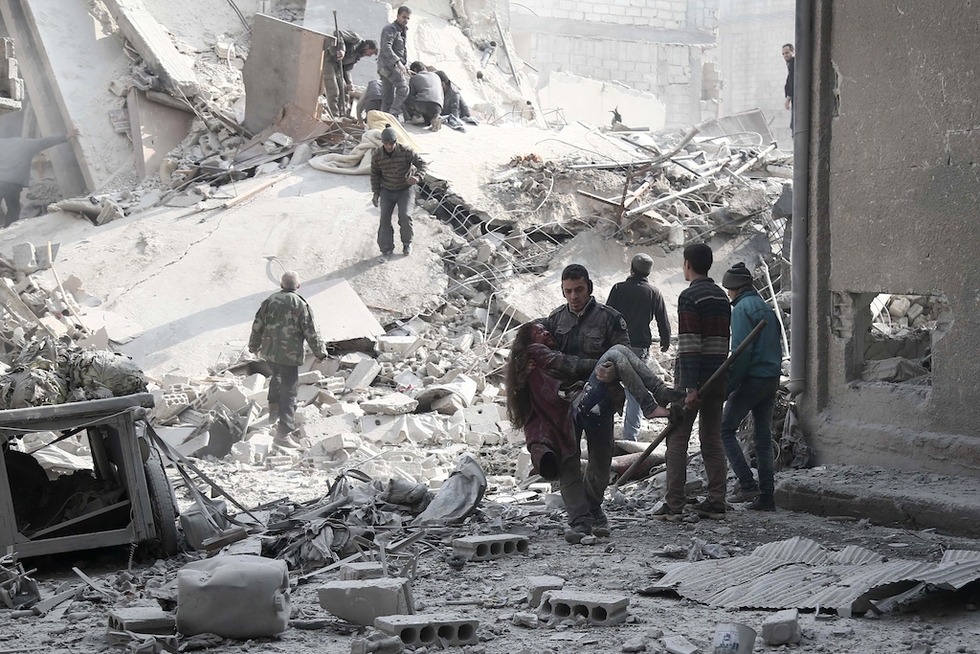Eastern Ghouta residents move from town to town 'with only the clothes on our backs'

AMMAN - The humanitarian crisis resulting from hundreds of air strikes over Eastern Ghouta in recent months is intensifying as residents say they are moving from town to town with little more than the clothes on their backs to escape an amorphous frontline.
Syrian government and opposition forces are currently battling over a government-held armoured vehicles base northeast of Damascus. The base sits almost completely surrounded by rebel territory in the encircled, rebel-held Eastern Ghouta enclave. For residents living close to the base, ground battles and an accompanying onslaught of government air strikes are pushing them to seek safety elsewhere.
One family fled their house in Harasta, a town immediately north of the base, after a government air strike flattened their home near the frontline last week.
"We left with only the clothes on our backs," Abd a-Rahman Kowki, a 51-year-old father of seven from Harasta told Syria Direct. The family left their home town one week ago amid government air strikes and nearby ground fighting. Their house, Kowki said, was "totally destroyed".
For two days, the shoe-store owner looked for an affordable new house while his wife and children squatted in a vacant shop several kilometres from their home.
Finally, he found one: a relatively cheap apartment on the third floor of a building in the rebel-held town of Misraba, three kilometres east. There, he says, he now relies on charity groups for food "to survive".
The only reason he can afford rent, Kowki said, is because of the apartment's location on the third and highest floor of the building, where it is most exposed to bombs.
"In much of East Ghouta, the houses on upper floors just go unused," he said.
Kowki is among thousands of other residents who fled Harasta over the past two weeks, after the Syrian government and rebel militias intensified a weeks-long battle over the armoured vehicles base that began in November.
At least 900 families have fled from Harasta alone within the past 12 days, estimates Hussam al-Beiruti, president of the town's local council. Harasta lies immediately north of the embattled armoured vehicles base. As many as 85 air strikes have hit Harasta since Wednesday morning, according to statistics posted online by the Syrian Civil Defence.
Eastern Ghouta, a collection of rebel-held suburbs immediately northeast of government-held Damascus proper, is included in the de-escalation deal brokered by Iran and Russia last May that established four ceasefire zones across the country.
But amid ongoing ground clashes, pro-government forces are unleashing a storm of air strikes and artillery shells over Eastern Ghouta, devastating the encircled enclave.
The impact of the bombardment, even outside Harasta, has been catastrophic. The UN counts at least 85 people, including 30 children, killed by air strikes and artillery fire across Eastern Ghouta since 31 December, according to a UNHCR statement published online Wednesday.
When you're in your own house, you can save up supplies for hard times ... but all of that is gone after being displaced
- Abu Hussein a-Rifaii, veterinarian
The enclave has been encircled by government forces since 2013. In recent months, however, the government has tightened the siege of Eastern Ghouta by closing a key trade crossing and capturing a network of smuggling tunnels that once brought in food and other supplies.
With the exception of some urgent medical cases, the government does not permit residents to leave Eastern Ghouta for surrounding government territory. Instead, those hoping to flee the bombs can only move within the enclave, even as government and alleged Russian air strikes pummel much of the area.
Neither Syrian state media outlet SANA nor Russian state news site TASS reported the bombings over the past week.
Aid workers and local councils within Eastern Ghouta are ill equipped to serve an influx of internally displaced families, Abu Ahmad Zain, head of Harasta’s pro-opposition media office, told Syria Direct. Main roads are targets for bombing attacks, he said.
'Even if they do make it, there is no shelter," Zain said. "And when there is shelter, it's too expensive."
Among the thousands of displaced people now living with no shelter of their own is 38-year-old Abu Hussein al-Rifaii, a veterinarian from Harasta.
Rifaai fled Harasta for the nearby town of Misraba last week with his wife and three children, but, unlike Kowki, couldn't find affordable housing.
Instead, he now shuffles from house to house, "between relatives and friends," every day.
His own house in Harasta was destroyed, he told Syria Direct, after a missile hit it last week. He left behind his job in Harasta, and has no money nor a place to store food and other necessities for his family.
"When you're in your own house, you can save up supplies for hard times," Rifaai said. "But all of that is gone after being displaced.
"We've returned to zero."
Read the original article on Syria Direct. Follow Syria Direct on Twitter.
Middle East Eye propose une couverture et une analyse indépendantes et incomparables du Moyen-Orient, de l’Afrique du Nord et d’autres régions du monde. Pour en savoir plus sur la reprise de ce contenu et les frais qui s’appliquent, veuillez remplir ce formulaire [en anglais]. Pour en savoir plus sur MEE, cliquez ici [en anglais].


